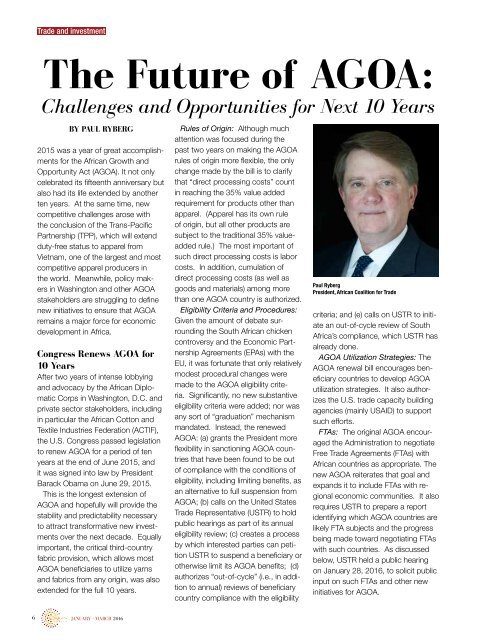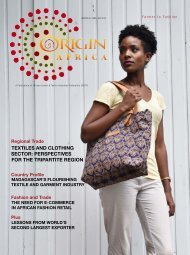You also want an ePaper? Increase the reach of your titles
YUMPU automatically turns print PDFs into web optimized ePapers that Google loves.
Trade and investment<br />
The Future of AGOA:<br />
Challenges and Opportunities for Next 10 Years<br />
BY PAUL RYBERG<br />
2015 was a year of great accomplishments<br />
for the <strong>Africa</strong>n Growth and<br />
Opportunity Act (AGOA). It not only<br />
celebrated its fifteenth anniversary but<br />
also had its life extended by another<br />
ten years. At the same time, new<br />
competitive challenges arose with<br />
the conclusion of the Trans-Pacific<br />
Partnership (TPP), which will extend<br />
duty-free status to apparel from<br />
Vietnam, one of the largest and most<br />
competitive apparel producers in<br />
the world. Meanwhile, policy makers<br />
in Washington and other AGOA<br />
stakeholders are struggling to define<br />
new initiatives to ensure that AGOA<br />
remains a major force for economic<br />
development in <strong>Africa</strong>.<br />
Congress Renews AGOA for<br />
10 Years<br />
After two years of intense lobbying<br />
and advocacy by the <strong>Africa</strong>n Diplomatic<br />
Corps in Washington, D.C. and<br />
private sector stakeholders, including<br />
in particular the <strong>Africa</strong>n Cotton and<br />
Textile Industries Federation (ACTIF),<br />
the U.S. Congress passed legislation<br />
to renew AGOA for a period of ten<br />
years at the end of June 2015, and<br />
it was signed into law by President<br />
Barack Obama on June 29, 2015.<br />
This is the longest extension of<br />
AGOA and hopefully will provide the<br />
stability and predictability necessary<br />
to attract transformative new investments<br />
over the next decade. Equally<br />
important, the critical third-country<br />
fabric provision, which allows most<br />
AGOA beneficiaries to utilize yarns<br />
and fabrics from any origin, was also<br />
extended for the full 10 years.<br />
Rules of <strong>Origin</strong>: Although much<br />
attention was focused during the<br />
past two years on making the AGOA<br />
rules of origin more flexible, the only<br />
change made by the bill is to clarify<br />
that “direct processing costs” count<br />
in reaching the 35% value added<br />
requirement for products other than<br />
apparel. (Apparel has its own rule<br />
of origin, but all other products are<br />
subject to the traditional 35% valueadded<br />
rule.) The most important of<br />
such direct processing costs is labor<br />
costs. In addition, cumulation of<br />
direct processing costs (as well as<br />
goods and materials) among more<br />
than one AGOA country is authorized.<br />
Eligibility Criteria and Procedures:<br />
Given the amount of debate surrounding<br />
the South <strong>Africa</strong>n chicken<br />
controversy and the Economic Partnership<br />
Agreements (EPAs) with the<br />
EU, it was fortunate that only relatively<br />
modest procedural changes were<br />
made to the AGOA eligibility criteria.<br />
Significantly, no new substantive<br />
eligibility criteria were added; nor was<br />
any sort of “graduation” mechanism<br />
mandated. Instead, the renewed<br />
AGOA: (a) grants the President more<br />
flexibility in sanctioning AGOA countries<br />
that have been found to be out<br />
of compliance with the conditions of<br />
eligibility, including limiting benefits, as<br />
an alternative to full suspension from<br />
AGOA; (b) calls on the United States<br />
Trade Representative (USTR) to hold<br />
public hearings as part of its annual<br />
eligibility review; (c) creates a process<br />
by which interested parties can petition<br />
USTR to suspend a beneficiary or<br />
otherwise limit its AGOA benefits; (d)<br />
authorizes “out-of-cycle” (i.e., in addition<br />
to annual) reviews of beneficiary<br />
country compliance with the eligibility<br />
Paul Ryberg<br />
President, <strong>Africa</strong>n Coalition for Trade<br />
criteria; and (e) calls on USTR to initiate<br />
an out-of-cycle review of South<br />
<strong>Africa</strong>’s compliance, which USTR has<br />
already done.<br />
AGOA Utilization Strategies: The<br />
AGOA renewal bill encourages beneficiary<br />
countries to develop AGOA<br />
utilization strategies. It also authorizes<br />
the U.S. trade capacity building<br />
agencies (mainly USAID) to support<br />
such efforts.<br />
FTAs: The original AGOA encouraged<br />
the Administration to negotiate<br />
Free Trade Agreements (FTAs) with<br />
<strong>Africa</strong>n countries as appropriate. The<br />
new AGOA reiterates that goal and<br />
expands it to include FTAs with regional<br />
economic communities. It also<br />
requires USTR to prepare a report<br />
identifying which AGOA countries are<br />
likely FTA subjects and the progress<br />
being made toward negotiating FTAs<br />
with such countries. As discussed<br />
below, USTR held a public hearing<br />
on January 28, 2016, to solicit public<br />
input on such FTAs and other new<br />
initiatives for AGOA.<br />
6 JANUARY - MARCH 2016



